Transform Dark Spaces: 21 Stunning Low-Light Hanging Plants for Lush Indoor Greenery
Indoor plants have an undeniable charm, instantly bringing life, freshness, and a calming aura to any space. However, the dream of a lush indoor jungle often bumps up against a common reality: not all homes are blessed with abundant natural light. Many aspiring plant parents find themselves struggling to select greenery that can truly thrive in dimly lit conditions. If you’ve ever felt the frustration of a wilting plant in a dark corner, you’re certainly not alone—I’ve experienced it too!
But here’s the good news: a lack of bright, sunny windows doesn’t mean you have to forgo the beauty of indoor plants. On the contrary, there’s a fantastic array of resilient and stunning plants that not only tolerate low-light environments but genuinely flourish in them. These adaptable beauties are perfect for adding a touch of nature to even the shadiest nooks and crannies of your home, transforming them into vibrant, living accents.
In this comprehensive guide, we’ll dive deep into the world of indoor gardening, introducing you to 21 spectacular low-light hanging plants. These plants are specifically chosen for their ability to thrive with minimal sunlight, making them ideal for apartments, offices, or any room that lacks direct sun exposure. From the ever-popular, cascading Pothos to the elegant, feathery fronds of various ferns, these plants will infuse your home with natural beauty and a sense of tranquility, regardless of how dim the lighting may be.
Prepare to explore these exceptionally easy-to-care-for options. Each plant comes with detailed insights into its appearance, affordability, growth habits, and most importantly, specific care instructions tailored to low-light conditions. We’ll also share creative styling tips to help you integrate these green gems seamlessly into your decor. Get ready to turn your low-light areas into lush, verdant havens that inspire and delight!
Top Low-Light Hanging Plants for Your Home
1. Pothos (Epipremnum aureum)
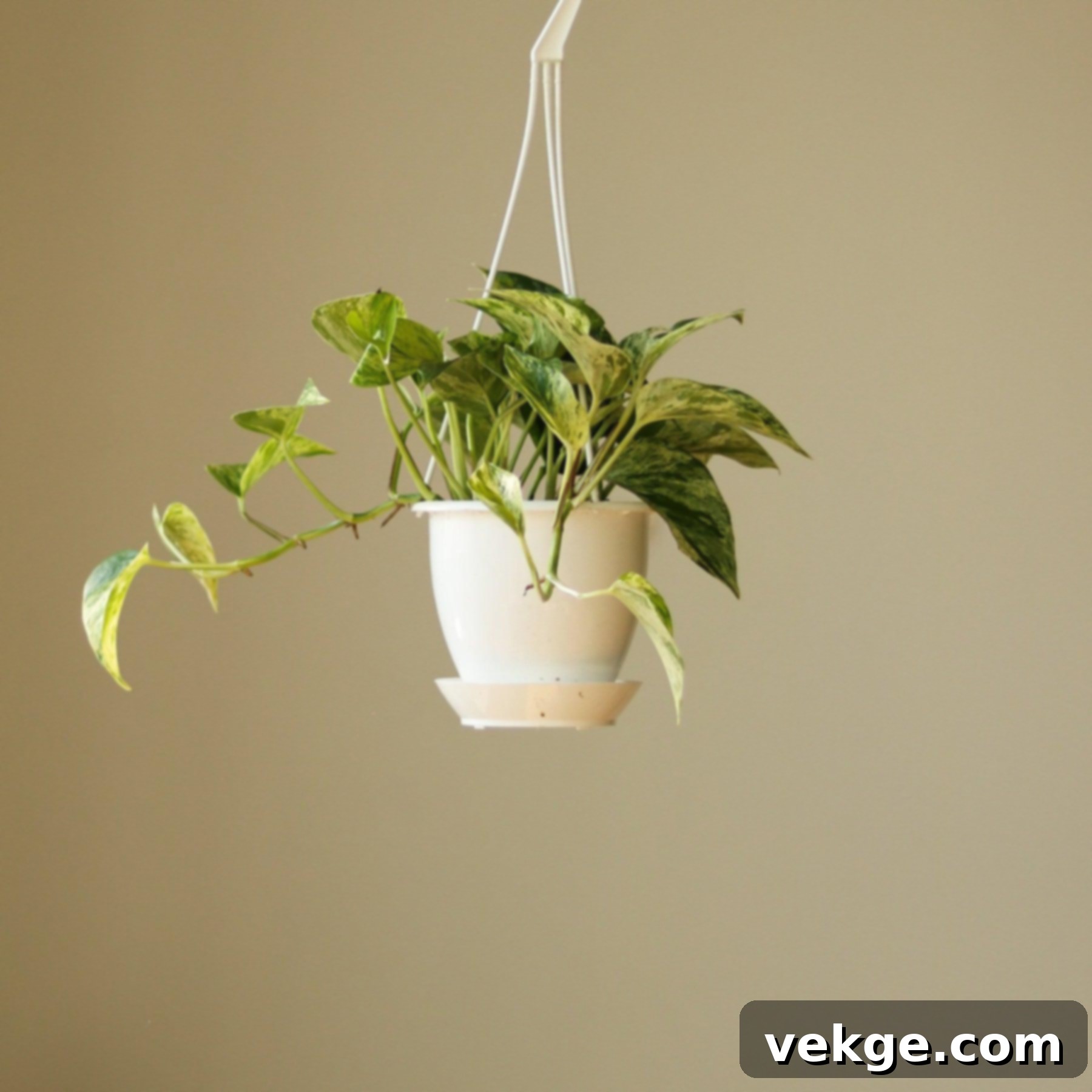
- Plant Appearance: Pothos boasts glossy, heart-shaped leaves that come in a variety of vibrant patterns. The most common varieties feature striking green with splashes or striations of yellow, gold, or white, adding a lively pop of color. Its trailing vines can grow quite long, making it perfect for dramatic displays.
- Price: Highly affordable and widely available, Pothos typically ranges from $5 to $20, depending on the pot size and specific variety (e.g., Golden Pothos, Marble Queen, Neon Pothos).
- Growth Habits: This plant is a remarkably fast-growing vine, renowned for its ability to trail elegantly from hanging baskets, climb up moss poles, or cascade gracefully from shelves. It’s incredibly versatile and forgiving.
| Why I Should Have This | Creative Styling Tips | Care Guide |
|---|---|---|
| Pothos is an absolute champion for low-light areas, adapting beautifully to less-than-ideal lighting conditions without losing its luster. | Enhance a bohemian aesthetic by hanging your Pothos in a handcrafted macrame holder, allowing its vines to spill down. | Light: Thrives in low to medium indirect light. Avoid direct sun, which can scorch its leaves. |
| Beyond its beauty, Pothos is a fantastic natural air purifier, effectively removing common household toxins like formaldehyde, benzene, and xylene from the air. | For a dynamic green accent, let its long tendrils cascade dramatically from high bookshelves, cabinet tops, or even across picture frames. | Water: Allow the top 2-3 inches of soil to dry out completely between waterings. It’s better to underwater slightly than overwater. |
| Considered one of the most low-maintenance and resilient houseplants, Pothos is forgiving of neglect and ideal for busy individuals or novice plant owners. | Train Pothos vines to climb up a moss pole or small trellis for vertical interest, creating a more compact and bushy look. | Soil: Use a well-draining potting mix that allows for good aeration and prevents waterlogging. |
| Its robust nature and ease of care make it an excellent choice for plant beginners looking to add greenery without much fuss. | Combine different Pothos varieties (e.g., ‘Neon’ and ‘Marble Queen’) in one large hanging basket for a striking, multi-textured display. | Humidity: Tolerates average household humidity but prefers moderate to high humidity. Occasional misting or a pebble tray can be beneficial. |
2. English Ivy (Hedera helix)

- Plant Appearance: English Ivy features charming, small, lobed leaves that are typically a deep, rich green. Many popular varieties showcase elegant creamy or yellow edges, adding a touch of variegation and brightness. Its dense foliage creates a lush, classic appearance.
- Price: English Ivy is generally moderately priced, ranging from $10 to $25, depending on the size of the plant and the specific cultivar.
- Growth Habits: This versatile plant is known for its vigorous trailing and climbing habits. It can beautifully cascade from hanging baskets, scale walls with proper support, or be trained around trellises, offering diverse styling options.
| Why I Should Have This | Creative Styling Tips | Care Guide |
|---|---|---|
| English Ivy excels in low to moderate indirect light, making it a perfect candidate for less illuminated rooms or hallways where other plants might struggle. | For a truly dramatic and elegant statement, hang a thriving English Ivy from a tall shelf or a sophisticated plant stand, allowing its long vines to drape gracefully towards the floor. | Light: Prefers low to moderate indirect light. Variegated varieties might appreciate slightly brighter, indirect light to maintain their colors. |
| Its intricate leaf shape and trailing form give it an elegant, classic, and timeless aesthetic that complements both traditional and modern decor styles. | Utilize English Ivy in a classic hanging basket near a window or in a room corner to create a cascading green waterfall effect, adding softness and texture. | Water: Keep the soil consistently moist but never soggy. Ensure good drainage to prevent root rot. Reduce watering slightly in winter. |
| Renowned for its air-purifying capabilities, English Ivy helps to remove airborne toxins such as benzene, formaldehyde, and trichloroethylene, improving indoor air quality. | Its pliable vines are excellent for creating living topiary forms or shaping around decorative elements, offering a unique and artistic touch to your home. | Soil: A well-draining, slightly acidic potting mix is ideal. A standard houseplant mix amended with some perlite works well. |
| The dense, textured foliage of English Ivy adds a rich layer of visual interest to any room, breaking up monotonous spaces and creating depth. | Consider pairing English Ivy with flowering plants in a mixed container for a stunning contrast of textures and colors, enhancing visual appeal. | Humidity: English Ivy thrives in high humidity. Mist regularly, especially in dry environments, or place it near a humidifier. |
3. Spider Plant (Chlorophytum comosum)
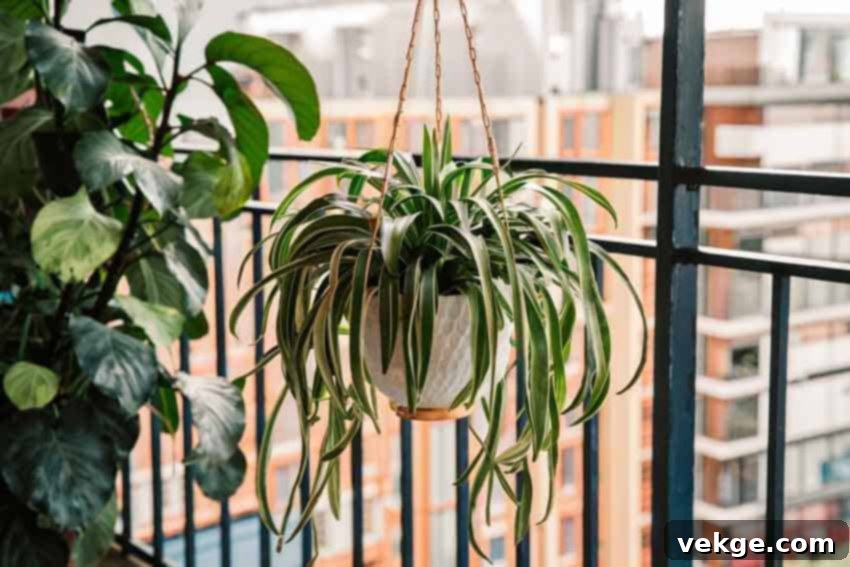
- Plant Appearance: Instantly recognizable by its arching, linear leaves that typically feature a distinctive green center with white or cream stripes along the edges. The most charming feature is its production of “spiderettes” or baby plantlets on long, slender stems, which elegantly trail downwards.
- Price: Spider plants are exceptionally budget-friendly and frequently shared among plant enthusiasts due to their prolific reproduction. Expect to pay between $5 and $15 for a mature plant.
- Growth Habits: This plant grows in a clumping fashion, sending out numerous long runners that bear tiny baby spider plants. These “spiderettes” create a stunning, cascading effect, making them ideal for hanging.
| Why I Should Have This | Creative Styling Tips | Care Guide |
|---|---|---|
| Spider plants are celebrated for their impressive air-purifying abilities, efficiently filtering out common toxins like formaldehyde and xylene from indoor air, contributing to a healthier living environment. | To truly highlight its unique “baby” plantlets, hang your Spider Plant in a high spot, allowing the long runners to dangle freely and create a dynamic, living curtain. | Light: Prefers medium to low indirect light. While it tolerates low light, brighter indirect light can encourage more spiderette production and vibrant variegation. |
| This is a truly “set it and forget it” plant. Its very low maintenance requirements mean it can tolerate occasional neglect, bouncing back quickly. | Place a Spider Plant in a sunny kitchen window or a bright living room corner for a classic, welcoming touch that brightens the space. | Water: Water thoroughly when the top inch of soil feels dry to the touch. Ensure proper drainage to prevent root rot. |
| Its forgiving nature and straightforward care make it an ideal choice for beginner gardeners or anyone looking for a no-fuss houseplant. | Perfect for a hanging basket, a tall plant stand, or a trailing pot on a shelf, showcasing its graceful, arching foliage and adorable offsets. | Soil: A general-purpose, well-draining potting mix is suitable. Avoid heavy soils that retain too much moisture. |
| Beyond air purification, it’s known to help remove household toxins and is safe for pets, making it a worry-free addition to homes with animals. | Propagate new plants from the spiderettes and share them with friends, spreading the joy of greenery. | Humidity: Tolerates average household humidity levels. Occasional misting or placing near a humidifier can be beneficial, especially in dry climates. |
4. Philodendron
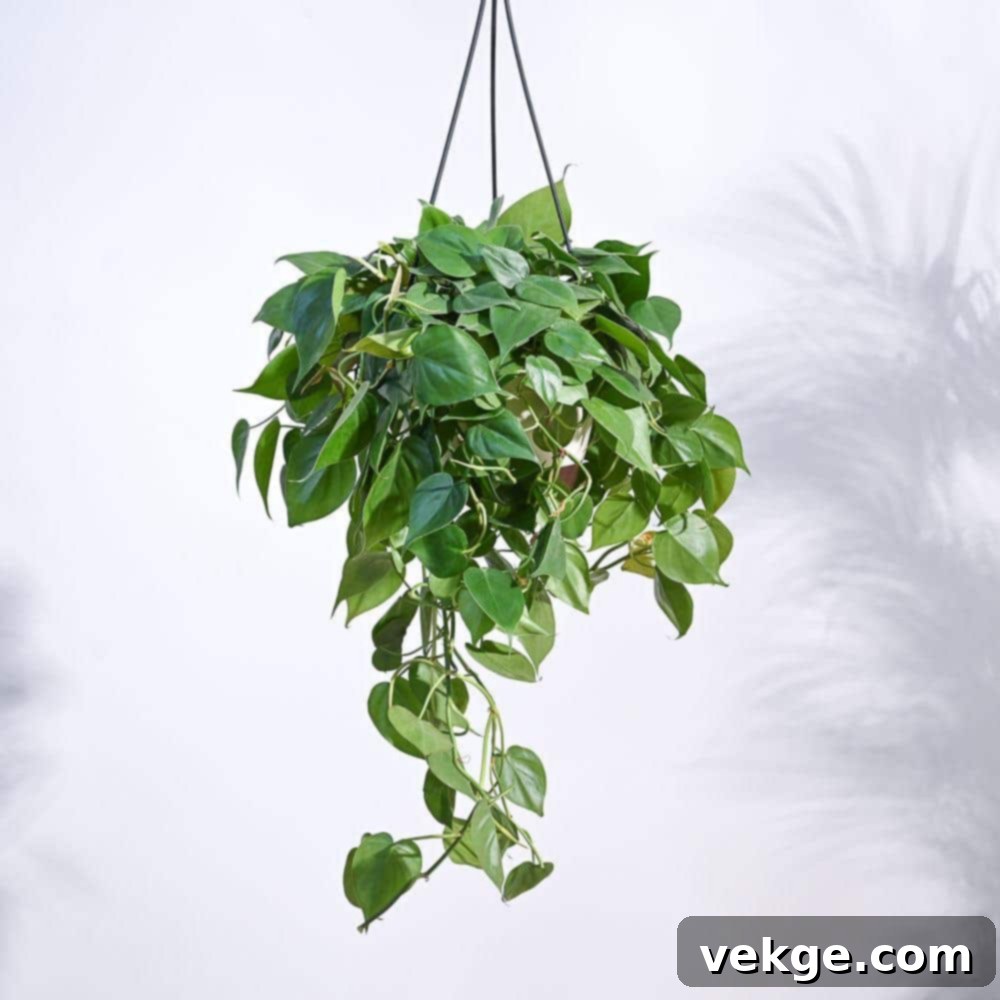
- Plant Appearance: Philodendrons encompass a wide variety of species, but many popular trailing types, like the Heart-Leaf Philodendron, feature large, glossy, heart-shaped green leaves. Shades can range from deep, emerald green to lighter, almost reddish-tinged new growth, offering subtle color variations.
- Price: Prices are moderate, typically ranging from $10 to $30, which can vary based on the specific variety and the size of the plant.
- Growth Habits: Most indoor Philodendrons are vigorous trailers or climbers, making them incredibly versatile. They are equally stunning in hanging baskets, where their vines can cascade, or trained up trellises or moss poles for a more upright, bushy appearance.
| Why I Should Have This | Creative Styling Tips | Care Guide |
|---|---|---|
| Philodendrons are renowned for their ability to thrive in low-light areas, making them an excellent choice for adding natural elegance to darker corners of your home or office. | Capitalize on its trailing nature by placing it in a hanging basket. Let its lush vines cascade freely, creating a beautiful green curtain effect in any room. | Light: Prefers low to medium indirect light. Direct sunlight can scorch its leaves, leading to yellowing or browning. |
| These plants are incredibly easy-going and forgiving, often bouncing back from a bit of neglect, which makes them perfect for busy individuals or those new to plant care. | For a more structured and dramatic look, train your Philodendron to climb up a decorative trellis or a moss pole, encouraging larger leaves and a vertical green statement. | Water: Allow the top 1-2 inches of soil to dry out between waterings. Philodendrons are susceptible to root rot if kept in constantly soggy soil. |
| Like many tropical plants, Philodendrons are effective at filtering indoor air, helping to remove airborne toxins and contributing to a fresher, healthier living environment. | Combine a Philodendron with other trailing or upright plants in a large container or plant grouping for a lush, multi-layered display that adds depth and texture. | Soil: A good quality, well-draining potting mix that retains some moisture but doesn’t become waterlogged is ideal. |
| Their natural climbing and trailing habits make them excellent candidates for vertical gardens or living wall installations, adding a dynamic element to your decor. | Position a Philodendron on a high shelf in a bathroom or kitchen, allowing its vines to spill over the edge, creating a spa-like or vibrant culinary ambiance. | Humidity: Philodendrons appreciate moderate to high humidity. Regular misting, a pebble tray, or placement near a humidifier can help keep their leaves vibrant. |
5. Heart-Leaf Philodendron (Philodendron hederaceum)

- Plant Appearance: This classic Philodendron cultivar is beloved for its iconic glossy, heart-shaped leaves, which are typically a rich, vibrant green. New leaves often emerge with a reddish tint, gradually maturing to a deep green, adding subtle color variation to its trailing vines.
- Price: Highly affordable and widely available, the Heart-Leaf Philodendron usually costs between $5 and $20, making it an accessible choice for all plant lovers.
- Growth Habits: A quintessential trailing plant, it excels in hanging baskets or gracefully cascading from shelves, bringing a soft, natural element to any space. Its vines can grow very long, creating a lush, flowing effect.
| Why I Should Have This | Creative Styling Tips | Care Guide |
|---|---|---|
| The Heart-Leaf Philodendron is famous for its impressive tolerance and ability to thrive in low-light conditions, making it perfect for brightening up dim rooms without direct sunlight. | Showcase its elegant trailing vines by hanging it from a high shelf, a curtain rod, or a ceiling hook, allowing its foliage to create an eye-catching, living display. | Light: Flourishes in low to medium indirect light. Too much direct sun can fade or burn its delicate leaves. |
| It’s an incredibly low-maintenance and resilient plant, forgiving of occasional missed waterings and making it an ideal companion for busy individuals or first-time plant owners. | Its long, adaptable vines are ideal for creating a lush indoor wall by training them along wires or small hooks, transforming a blank surface into a vibrant green feature. | Water: Water when the top 1-2 inches of soil feel dry to the touch. Ensure good drainage to prevent waterlogging, which can lead to root rot. |
| Like its Philodendron cousins, this plant helps clean indoor air by absorbing common pollutants, contributing to a healthier and fresher living environment. | Pair it with other trailing plants like Pothos or Spider Plants in a multi-tiered stand or basket arrangement for a layered, abundant, and textural display. | Soil: A well-draining potting mix, rich in organic matter, will provide the best growing medium. |
| Its forgiving nature and beautiful appearance make it one of the most suitable plants for beginners looking to add trailing greenery to their home. | Allow it to cascade from a plant stand next to a comfortable reading chair, bringing a natural, calming element to your relaxation zone. | Humidity: Prefers moderate humidity. While it tolerates average household levels, occasional misting or a pebble tray can encourage lusher growth. |
6. String of Hearts (Ceropegia woodii)
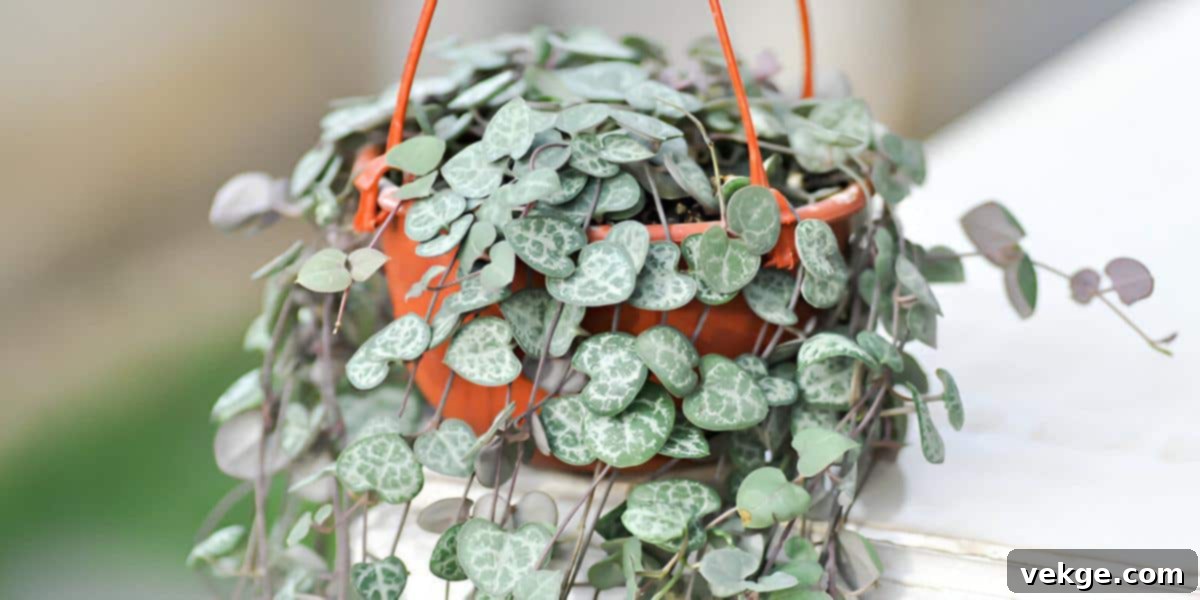
- Plant Appearance: This captivating succulent features delicate, heart-shaped leaves that grow in pairs along thin, wiry, trailing vines. The leaves are typically a mosaic of green and silver patterns, often with beautiful purple undersides, adding to its unique charm and romantic appeal.
- Price: The String of Hearts is moderately priced, usually ranging from $15 to $30, reflecting its unique appearance and popularity among collectors.
- Growth Habits: This plant is a true trailing marvel, with vines that can grow several feet long. It’s ideally suited for hanging baskets or high shelves where its exquisite heart-shaped foliage can cascade freely, creating a waterfall of green and silver.
| Why I Should Have This | Creative Styling Tips | Care Guide |
|---|---|---|
| Its truly unique and romantic appearance, with intricate patterns and delicate heart-shaped leaves, makes it an instant conversation starter and a favorite among plant enthusiasts. | Hang it high in a visible location where its delicate, patterned, heart-shaped leaves can be admired as they gracefully trail downwards, creating a truly enchanting display. | Light: Thrives in bright, indirect light. While it tolerates lower light, its variegation will be more pronounced in good light. Avoid harsh direct sun. |
| The String of Hearts is remarkably easy to care for and has low-water needs, making it a perfect plant for those who tend to forget watering or travel frequently. | It looks particularly charming in macrame holders or minimalist ceramic pots placed in a well-lit room, complementing a variety of interior design styles. | Water: As a succulent, allow the soil to dry out completely between waterings. Overwatering is the most common cause of problems. |
| Its delicate structure and trailing habit make it an excellent choice for small spaces, adding greenery and character without overwhelming the area. | Create a captivating multi-plant display by mixing the String of Hearts with other trailing succulents or small cacti for a diverse and textural arrangement. | Soil: Requires a very well-draining, gritty potting mix, such as a cactus or succulent blend, to prevent root rot. |
| As a succulent, it is naturally drought-tolerant, storing water in its leaves, which makes it incredibly resilient and forgiving. | Position it near a window where it can catch the morning or late afternoon sun, which will enhance the purple hues on the undersides of its leaves. | Humidity: Tolerates average household humidity levels. It does not require high humidity and can suffer if conditions are too damp. |
7. Boston Fern (Nephrolepis exaltata)

- Plant Appearance: The Boston Fern is celebrated for its lush, arching, feathery fronds that are a vibrant, classic green. Its dense growth habit creates a full, bushy, and elegant appearance, perfect for adding texture and volume to any space.
- Price: Moderately priced, you can typically find a Boston Fern for $10 to $25, depending on its size and maturity.
- Growth Habits: This fern has a clumping growth habit, with fronds emerging from a central rhizome. It works exceptionally well in hanging baskets, where its fronds can gracefully spill over the sides, or as a stately tabletop plant with its naturally bushy and rounded form.
| Why I Should Have This | Creative Styling Tips | Care Guide |
|---|---|---|
| The Boston Fern instantly adds a sense of lush, vibrant greenery and natural elegance to any space, making it feel more alive and serene. | It’s an ideal choice for hanging in bathrooms, as it absolutely thrives in the naturally high humidity of these spaces, creating a spa-like atmosphere. | Light: Prefers indirect light. Direct sunlight will scorch its delicate fronds. A north-facing window or a well-lit room away from the window is perfect. |
| Beyond its beauty, Boston Ferns are known for their excellent air-purifying abilities, effectively removing pollutants like formaldehyde and xylene from indoor air. | Place your Boston Fern in classic terracotta pots or decorative ceramic planters to complement traditional, cottagecore, or even boho-chic decor styles. | Water: Keep the soil consistently moist but not soggy. Do not allow the soil to dry out completely between waterings, as this can stress the plant. |
| Its abundant, feathery foliage helps to create a distinctly tropical and refreshing feel, bringing a touch of the rainforest into your home. | Group several Boston Ferns or mix them with other shade-loving ferns to create a mini indoor jungle effect, adding depth and varying textures. | Soil: A rich, well-draining potting mix with plenty of organic matter is essential. A peat-based mix is often recommended. |
| This fern is perfectly suited for humid areas like bathrooms or kitchens, where it will truly flourish and maintain its vibrant green appearance. | Consider hanging it near a reading nook or in a sunroom to enjoy its calming presence and air-purifying benefits while relaxing. | Humidity: Requires high humidity to thrive. Mist regularly, use a humidifier, or place it on a pebble tray filled with water to increase moisture in the air. |
8. Bird’s Nest Fern (Asplenium nidus)
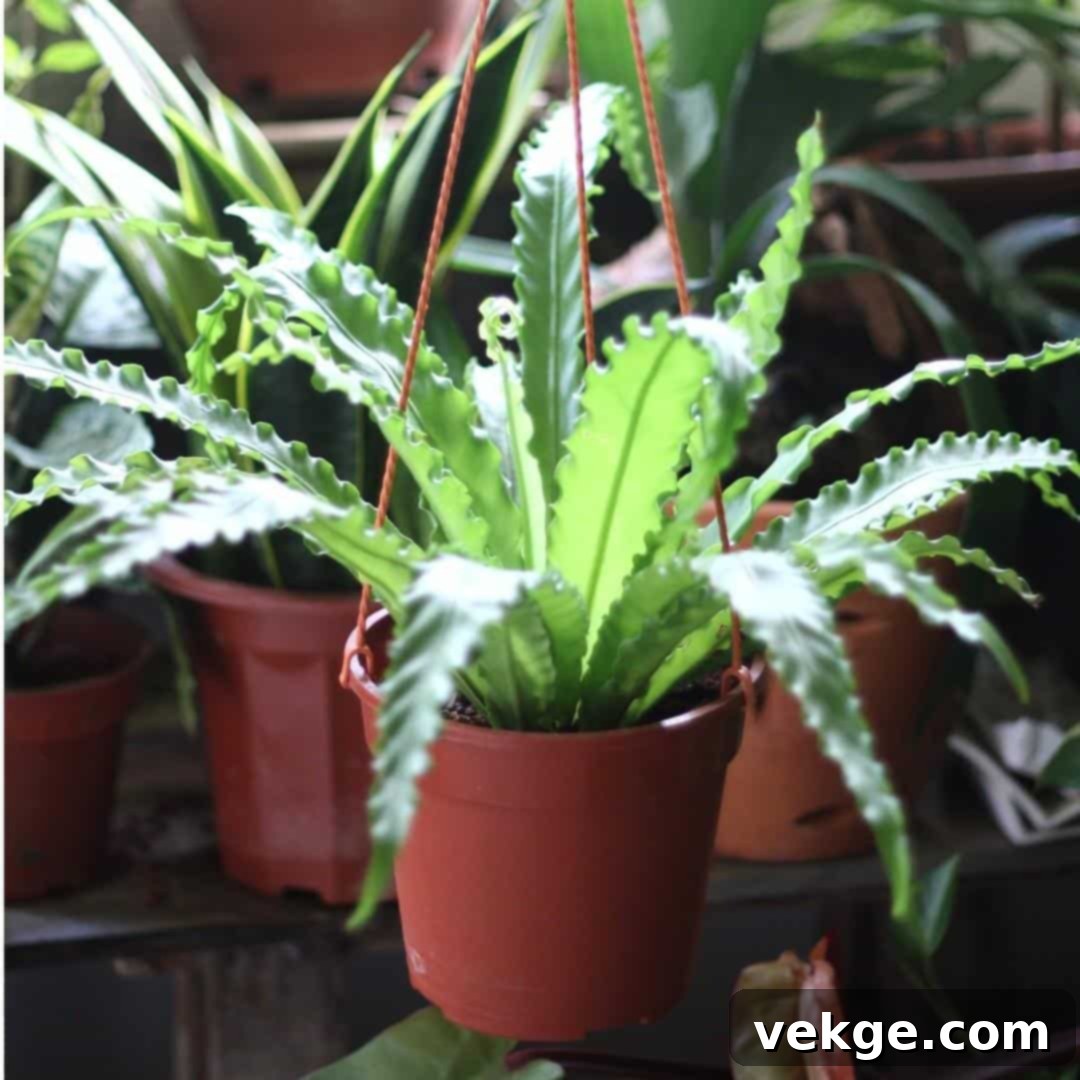
- Plant Appearance: The Bird’s Nest Fern is easily identified by its distinctive, broad, glossy fronds that emerge from a central rosette, creating a striking “nest-like” shape. The fronds are typically bright green, often with wavy or ruffled edges, adding an architectural element to its natural beauty.
- Price: Moderately priced, expect to pay between $15 and $30 for a healthy Bird’s Nest Fern, depending on its size and maturity.
- Growth Habits: This fern has a clumping growth habit, growing outwards from its central “nest.” It looks magnificent in hanging planters, allowing its fronds to arch gracefully, or as a sculptural tabletop plant, making a bold statement.
| Why I Should Have This | Creative Styling Tips | Care Guide |
|---|---|---|
| Its unique leaf shape and growth habit add a strong element of architectural interest and tropical flair, making it a standout plant in any collection. | Hang it near a window that receives bright, filtered light (e.g., a north or east-facing window) to showcase its glossy fronds without risking sunburn. | Light: Thrives in low to medium indirect light. Avoid direct sunlight, which can scorch its leaves. |
| The Bird’s Nest Fern naturally thrives in humid environments, making it a perfect plant for bathrooms, kitchens, or homes with humidifiers. | It’s an excellent plant for bathrooms, where it can revel in the natural humidity from showers, creating a lush, spa-like sanctuary. | Water: Water when the top inch of soil feels dry. Water around the base of the plant, avoiding pouring water directly into the central “nest” as this can lead to rot. |
| Its bold, vibrant green fronds bring an undeniable tropical vibe to any indoor space, instantly transporting you to a rainforest oasis. | Place it in a decorative ceramic or terracotta pot that complements your decor, adding to its stylish appeal as a focal point. | Soil: A well-draining, slightly acidic potting mix rich in organic matter is preferred. An orchid mix or a blend with bark and perlite can work well. |
| Despite its exotic appearance, this fern is relatively low-maintenance and quite hardy, making it suitable for both experienced and novice plant parents. | Group it with other tropical plants to create a cohesive indoor jungle theme, benefiting from the shared humidity. | Humidity: Requires high humidity to prevent frond tips from browning. Mist regularly, use a humidifier, or place it on a pebble tray. |
9. Staghorn Fern (Platycerium bifurcatum)
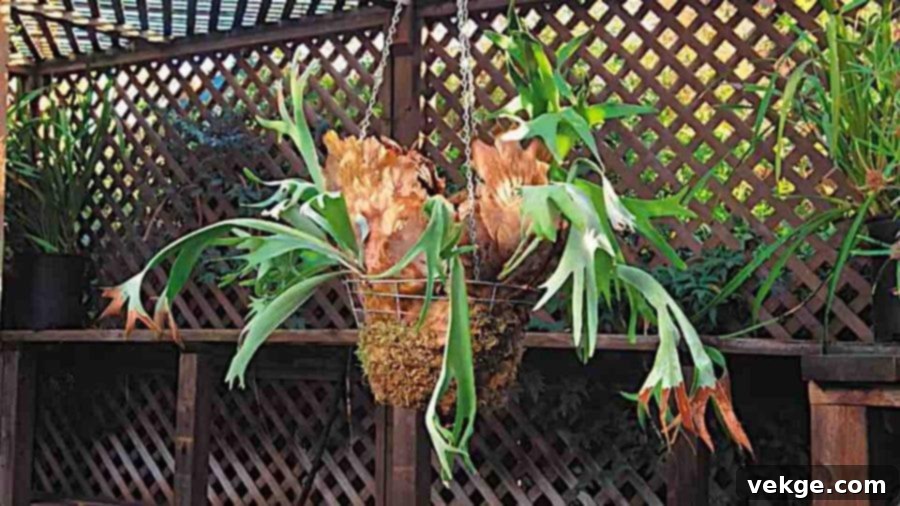
- Plant Appearance: The Staghorn Fern is truly unique, featuring two distinct types of fronds. The fertile fronds are green, forked, and resemble deer or elk antlers, growing outwards in a spectacular, sculptural fashion. The sterile basal fronds are flat, roundish, and brownish, clinging to the mounting surface and serving to protect the roots.
- Price: Due to its unique nature and often being sold mounted, Staghorn Ferns are typically on the higher end, ranging from $20 to $50, depending on size and presentation.
- Growth Habits: As an epiphytic plant, the Staghorn Fern naturally grows on trees in its native habitat. Indoors, it’s most commonly mounted on wooden boards or bark slabs, mimicking its natural growth, but can also be grown in specialized hanging baskets with appropriate media.
| Why I Should Have This | Creative Styling Tips | Care Guide |
|---|---|---|
| Its striking, sculptural appearance, with fronds resembling deer antlers, makes it a living work of art and an undeniable focal point in any room. | Mount your Staghorn Fern on a beautiful piece of reclaimed wood or bark for a stunning, minimalist living wall accent that instantly elevates your decor. | Light: Prefers medium to bright indirect light. Avoid direct sun, which can scorch its fronds. A north or east-facing window is ideal. |
| This plant is an incredible conversation piece, guaranteed to draw attention and intrigue from anyone who sees it due to its unusual form. | For an added dimension, place it in a large hanging basket or mount it as part of a gallery wall, complementing other natural textures and artwork. | Water: As an epiphyte, it doesn’t grow in soil. Instead, soak the entire root ball (or mounted portion) in a tub of water for 15-20 minutes when the fronds feel dry and light. Mist regularly. |
| It brings a wild, natural, and raw aesthetic indoors, connecting your living space to the untamed beauty of the rainforest. | Create an immersive jungle theme by combining your Staghorn Fern with other epiphytic plants like air plants or orchids, fostering a lush, layered environment. | Soil: Not grown in traditional soil. For mounted plants, use sphagnum moss. For hanging baskets, an orchid bark mix or epiphytic blend is suitable. |
| Once established and its specific watering needs are understood, the Staghorn Fern is surprisingly easy to care for and incredibly hardy. | Position it in an area where it receives good air circulation, enhancing its health and natural habitat feel. | Humidity: Prefers moderate to high humidity. Regular misting, especially in dry indoor environments, is crucial for healthy frond development. |
10. Maidenhair Fern (Adiantum)
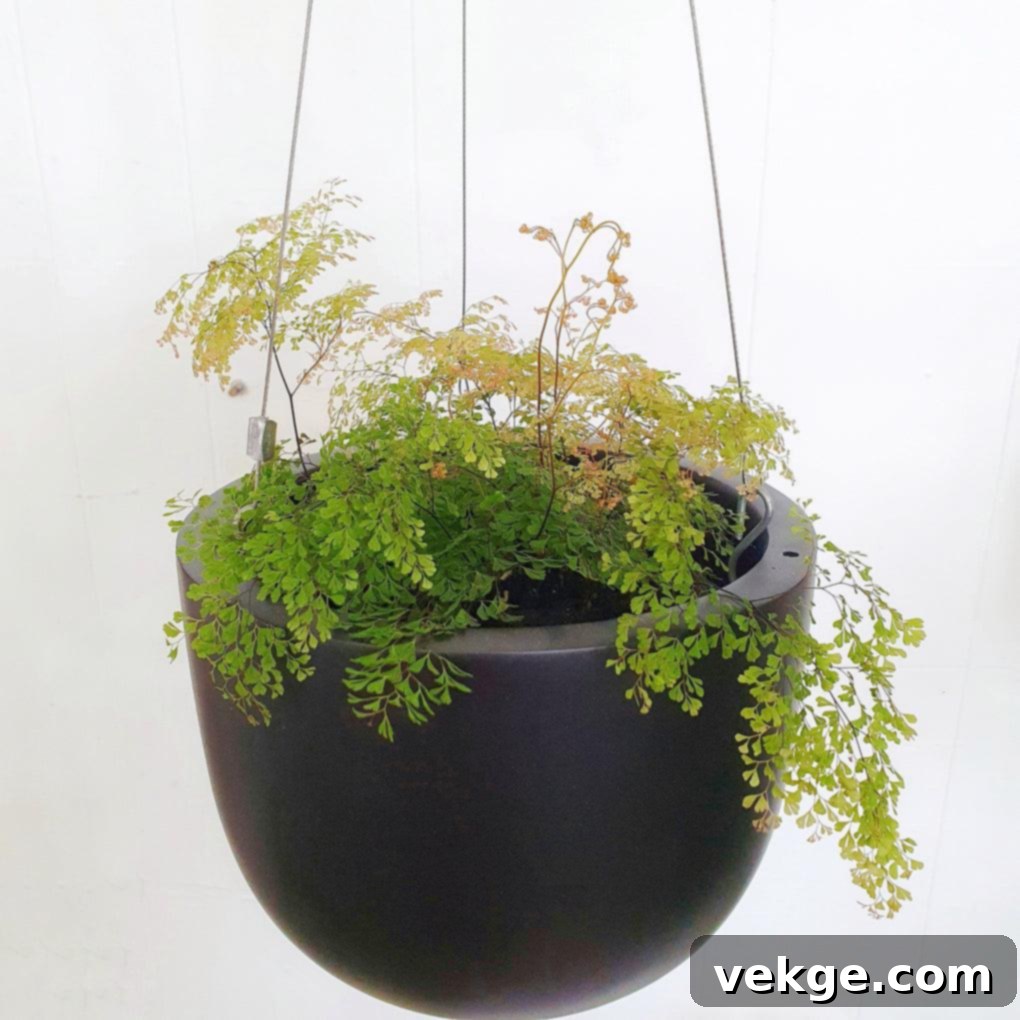
- Plant Appearance: The Maidenhair Fern is perhaps the most delicate and enchanting of all ferns. It features incredibly fine, lace-like leaflets arranged on thin, wiry, often black or dark brown stems. The fronds are soft, airy, and feathery, creating a cloud-like texture that is uniquely graceful.
- Price: Generally moderate, a Maidenhair Fern usually costs between $10 and $25, reflecting its distinctive beauty and slightly more specific care requirements.
- Growth Habits: This fern forms beautiful clumps of delicate fronds. While it can be a stunning tabletop plant, its airy texture is particularly captivating in hanging baskets, where its ethereal foliage can sway gently.
| Why I Should Have This | Creative Styling Tips | Care Guide |
|---|---|---|
| Its exceptionally elegant and delicate appearance adds a touch of refined beauty and softness, making it a sophisticated addition to any interior. | Hang your Maidenhair Fern near windows that receive only indirect light, allowing its graceful fronds to capture subtle movements and light, enhancing its ethereal beauty. | Light: Requires low to moderate indirect light. Direct sunlight is detrimental and will quickly burn its delicate fronds. |
| Maidenhair Ferns absolutely thrive in consistently humid environments, making them a perfect plant for bathrooms, kitchens, or terrariums. | It works beautifully in humid spaces like bathrooms or kitchens, where it can enjoy the moisture in the air and create a natural, tranquil ambiance. | Water: Keep the soil consistently moist but never waterlogged. Do not allow the soil to dry out, even for a short period, as this can cause fronds to crisp up rapidly. |
| The fine texture and intricate pattern of its fronds add a unique softness and visual interest to decor, contrasting wonderfully with bolder, more rigid plant forms. | Plant it in natural clay pots or unglazed ceramic planters for an earthy, organic look that complements its delicate form. | Soil: A rich, well-draining potting mix that retains moisture, such as a peat-based mix with added perlite or vermiculite, is essential. |
| It requires minimal direct sunlight, allowing you to brighten up even the shadiest corners of your home with its exquisite green. | Position it as a centerpiece on a side table or coffee table, letting its delicate fronds create a gentle, inviting focal point. | Humidity: High humidity is absolutely crucial for the Maidenhair Fern’s survival. Mist several times a day, use a humidifier, or place it on a constantly wet pebble tray. |
11. String of Pearls (Senecio rowleyanus)

- Plant Appearance: This truly unique succulent is named for its distinctive, bead-like leaves that resemble a string of pearls, growing along long, delicate trailing stems. The bright green, spherical foliage creates a visually captivating and whimsical effect, unlike any other plant.
- Price: String of Pearls is moderately priced, typically ranging from $15 to $30, reflecting its sought-after appearance and popularity among succulent collectors.
- Growth Habits: A quintessential trailing succulent, it is perfectly suited for hanging baskets or high shelves, where its long, beaded strands can cascade freely, often growing several feet long and creating a stunning waterfall of “pearls.”
| Why I Should Have This | Creative Styling Tips | Care Guide |
|---|---|---|
| Its highly unusual and eye-catching appearance makes it a unique decorative element, guaranteed to draw compliments and add a whimsical touch to any space. | Hang it high from a ceiling hook or a tall shelf to fully showcase its impressive, long, beaded strands as they gracefully drape downwards. | Light: Requires bright, indirect light to thrive. A spot near a south or west-facing window, slightly away from direct sun, is ideal. |
| As a succulent, it has minimal water requirements, making it incredibly forgiving for those who tend to forget to water or prefer low-maintenance plants. | It looks particularly striking in macrame holders or minimalist ceramic pots, especially in well-lit spaces where its unique form can be appreciated. | Water: Allow the soil to dry out completely between waterings, then water thoroughly. Overwatering is the most common killer of String of Pearls. |
| Its delicate and compact root system makes it an excellent choice for small spaces, adding green interest without taking up much room. | Combine it with other trailing succulents or small cacti in a mixed display for textural variety and to create a desert-inspired vignette. | Soil: A very well-draining cactus or succulent mix is essential to prevent waterlogging and root rot. |
| Being drought-tolerant and relatively easy to care for, it’s a robust choice for adding unique texture and visual intrigue to your plant collection. | Place it where it gets good air circulation to mimic its natural arid environment and prevent fungal issues. | Humidity: Tolerates average to low household humidity. It does not require high humidity and thrives in drier conditions. |
12. Burro’s Tail (Sedum morganianum)
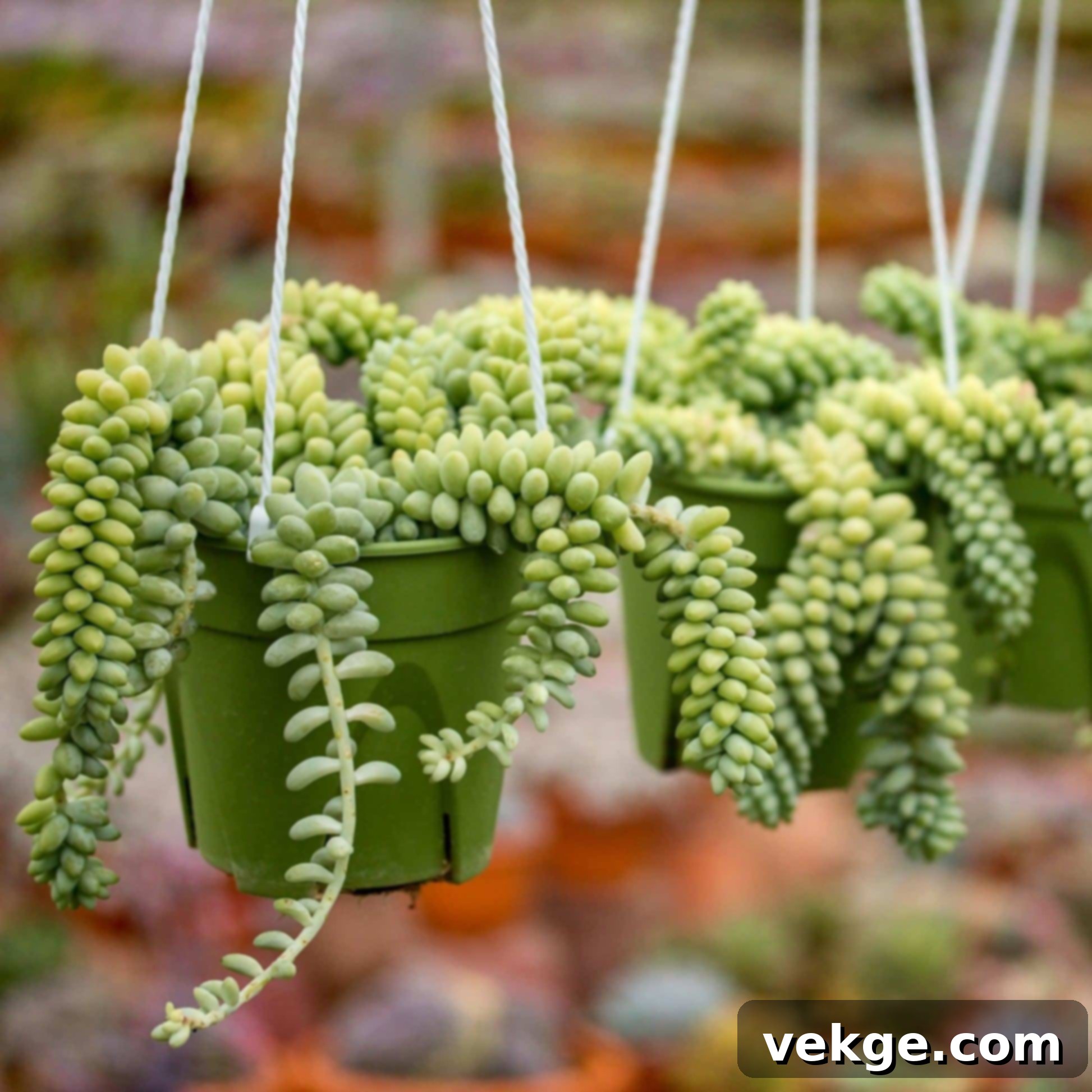
- Plant Appearance: The Burro’s Tail succulent is famed for its thick, trailing stems that are densely covered in plump, teardrop-shaped, light green leaves. These succulent leaves overlap tightly, creating a visually striking resemblance to a donkey’s or burro’s tail, hence its common name.
- Price: Generally moderately priced, you can find a Burro’s Tail for around $10 to $25, with larger specimens commanding higher prices.
- Growth Habits: This plant is a fantastic trailer, with stems that can grow several feet long. It’s perfectly suited for hanging baskets or high shelves where its heavy, cascading stems can spill over, creating a wonderfully unique and textural display.
| Why I Should Have This | Creative Styling Tips | Care Guide |
|---|---|---|
| Its plump, succulent leaves add incredible texture and a unique architectural element to any plant collection, making it a standout feature. | Hang it in a bright spot where its long, thick strands can fully unfurl and drape, creating a captivating focal point that draws the eye. | Light: Prefers bright, indirect light. It can tolerate some direct morning sun but avoid intense afternoon sun, which can scorch the leaves. |
| As a succulent, it’s remarkably drought-tolerant and requires very little maintenance, making it perfect for busy individuals or those new to plant care. | It’s an excellent addition to succulent arrangements on shelves or windowsills, providing a unique trailing dimension that contrasts with upright varieties. | Water: Water sparingly. Allow the soil to dry out completely between waterings, typically every 2-4 weeks, depending on light and temperature. |
| Its distinctive appearance is truly eye-catching and unique, offering a conversation starter and a refreshing change from more common houseplants. | Combine it with other cacti and succulents in a shallow, wide pot for a stunning desert-themed arrangement, celebrating diverse textures. | Soil: Absolutely requires a well-draining cactus or succulent mix to prevent root rot. Good aeration is key. |
| It thrives in warm, dry spaces, making it ideal for sunny windowsills or rooms that don’t retain much humidity. | Be gentle when handling, as its leaves detach easily. Collect fallen leaves for propagation! | Humidity: Prefers low humidity. High humidity can lead to fungal issues or rot. |
13. Swedish Ivy (Plectranthus verticillatus)
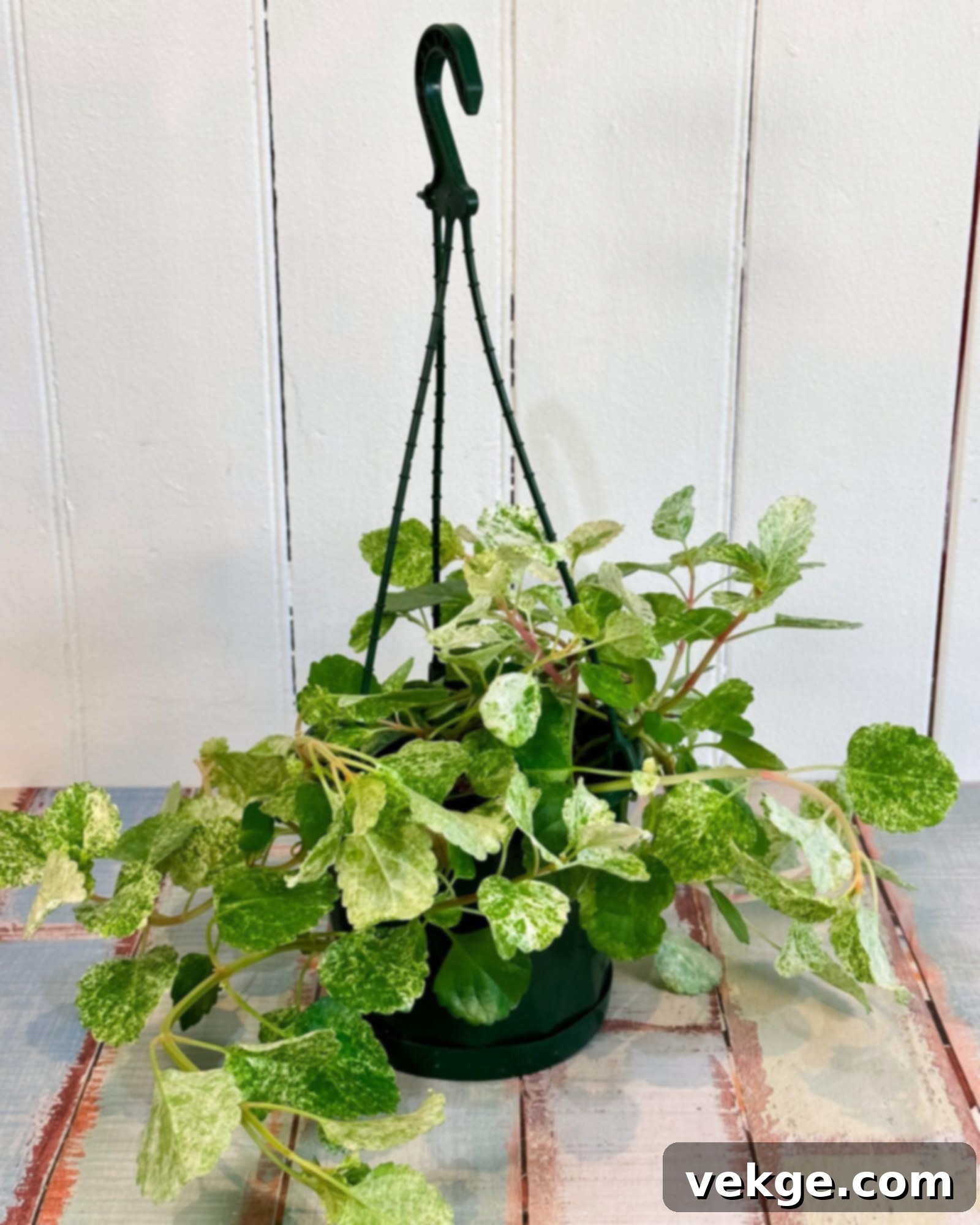
- Plant Appearance: Swedish Ivy features shiny, vibrant green leaves with distinctly scalloped or toothed edges, giving it a charming texture. When happy, it can produce small, delicate tubular white or pale lavender flowers that emerge on slender stalks, adding an extra touch of beauty.
- Price: Exceptionally affordable, Swedish Ivy typically costs between $5 and $15, making it an accessible and generous plant for all.
- Growth Habits: This plant is a vigorous and fast-growing trailer, making it an excellent choice for hanging baskets, where its abundant foliage can create a lush cascade. It also works beautifully in window boxes or as a groundcover in mixed containers.
| Why I Should Have This | Creative Styling Tips | Care Guide |
|---|---|---|
| Swedish Ivy is incredibly easy to care for and remarkably fast-growing, quickly filling out a space with its cheerful green foliage. | Utilize its robust trailing habit in hanging baskets placed in kitchens, living rooms, or even sheltered patios to highlight its abundant, flowing stems. | Light: Thrives in low to medium indirect light. While it tolerates lower light, brighter light encourages denser growth and more flowers. |
| Its lush, bright green leaves add vibrant greenery and a touch of classic charm to any space, instantly making it feel more alive and welcoming. | It’s versatile enough for both indoor and outdoor hanging pots (in warm climates), providing continuous greenery and occasional blooms. | Water: Keep the soil consistently moist but not soggy. Do not allow the soil to dry out completely, especially during warmer months. |
| This adaptable plant works well in virtually any room, from bright windows to more shaded corners, offering flexibility in placement. | It looks wonderfully lush and full when paired with other trailing plants in a larger planter, creating a diverse and abundant green display. | Soil: A general-purpose, well-draining potting mix with good organic content is perfectly suitable. |
| Its forgiving nature and straightforward requirements make it an ideal houseplant for beginners who are just starting their green journey. | Propagate cuttings easily in water to share with friends or create more plants for a truly abundant display. | Humidity: Tolerates average household humidity levels. While not strictly necessary, occasional misting can benefit its foliage. |
14. Lipstick Plant (Aeschynanthus radicans)
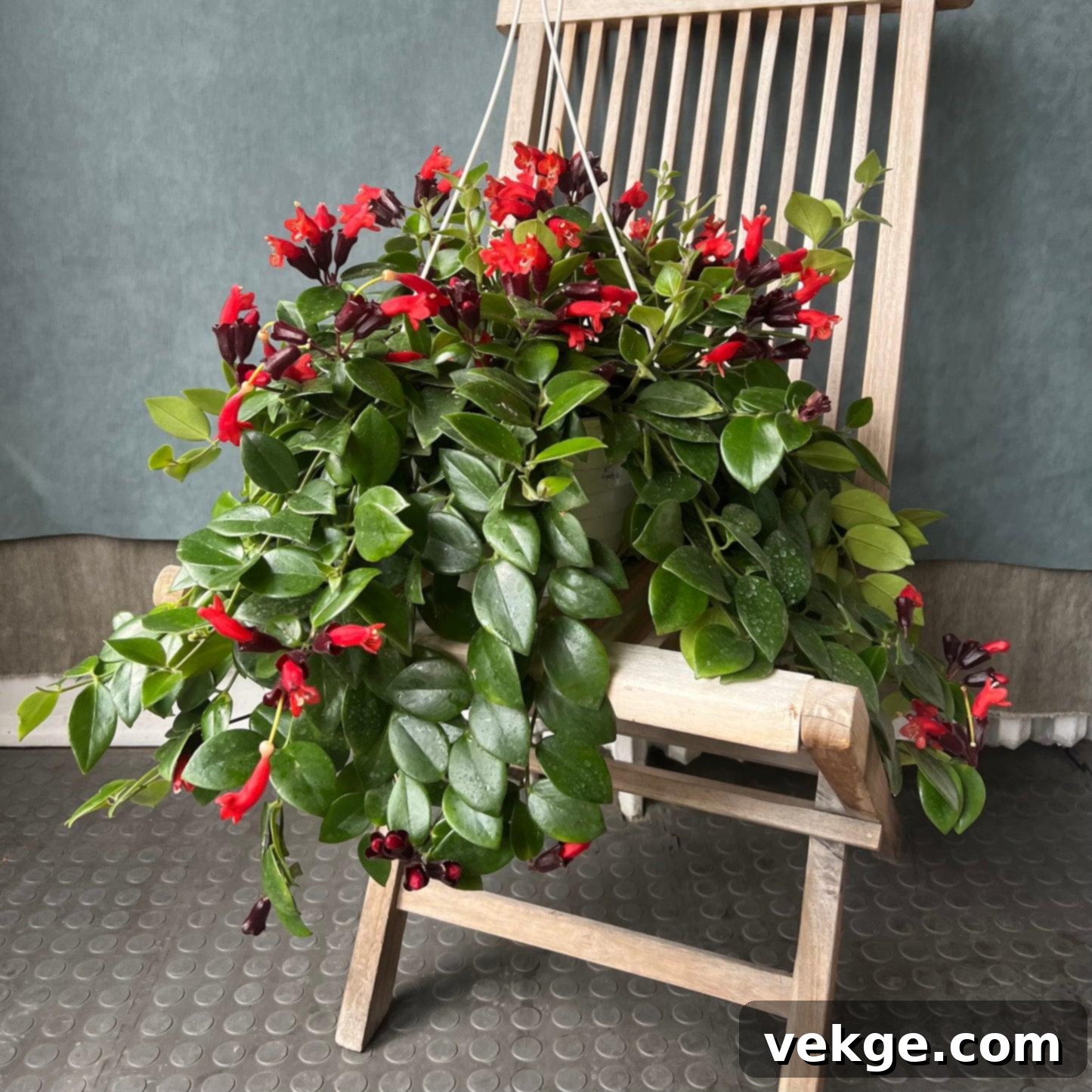
- Plant Appearance: The Lipstick Plant is celebrated for its attractive glossy, dark green leaves and, more notably, its truly spectacular flowers. Vibrant red, tube-shaped blooms emerge from dark, purplish calyces, creating the illusion of a lipstick tube popping open, hence its evocative name.
- Price: Moderately priced, you can typically find a Lipstick Plant for around $15 to $30, especially when it’s in bloom.
- Growth Habits: This plant has a wonderful trailing or climbing habit. It absolutely thrives in hanging baskets, allowing its long stems and colorful flowers to spill over, or can be trained to climb a small wall trellis for a vertical burst of color.
| Why I Should Have This | Creative Styling Tips | Care Guide |
|---|---|---|
| Its vibrant, unique flowers provide a stunning pop of color, making it a living centerpiece and a cheerful addition to any room. | Hang it in a well-lit spot where its striking blooms can be fully admired, perhaps near a window (out of direct sun) or in a bright living area. | Light: Prefers bright, indirect light. While it tolerates lower light, it needs good light to flower abundantly. Avoid harsh direct sunlight. |
| It’s relatively easy to care for and uniquely beautiful, offering both appealing foliage and a show-stopping floral display. | It’s a fantastic choice for hanging baskets in kitchens or living rooms, bringing a tropical and exotic touch that brightens the space. | Water: Allow the top inch of soil to dry out between waterings. Ensure good drainage to prevent root rot. |
| The combination of its glossy leaves and vivid flowers creates a distinctly tropical look that complements various decor styles, from modern to eclectic. | Pot it in a decorative ceramic or terracotta pot that highlights its colorful blooms, adding an extra layer of design to your plant display. | Soil: A well-draining, airy potting mix that mimics its epiphytic nature (e.g., orchid mix or a blend with perlite and bark) is ideal. |
| Its natural trailing habit and beautiful flowers make it an ideal choice for hanging indoors, bringing height and visual interest to your plant collection. | Group it with other tropical foliage plants to create a lush, multi-textured display that evokes a rainforest feel. | Humidity: Prefers moderate to high humidity. Misting regularly, especially during blooming periods, can encourage healthier growth and more flowers. |
15. Peperomia
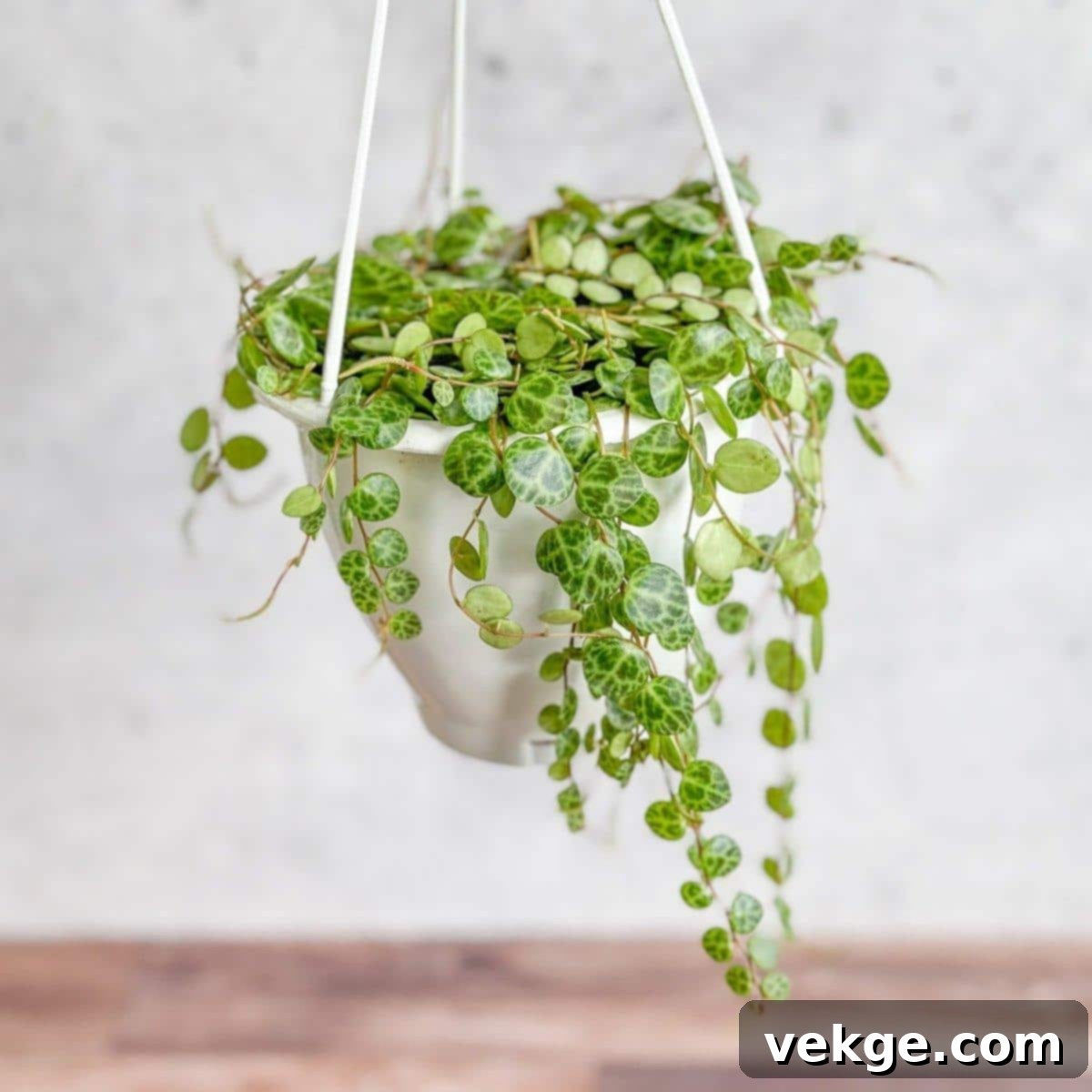
- Plant Appearance: Peperomia is a wonderfully diverse genus with countless varieties, all sharing a generally compact growth habit and often succulent-like leaves. Their foliage comes in an astonishing array of shapes, textures, and colors—from deep green and glossy to variegated, red-edged, or even wrinkled, offering endless visual interest.
- Price: Peperomia plants are generally affordable, typically ranging from $5 to $20, depending on the specific variety and size, making them accessible to all.
- Growth Habits: While many Peperomias are compact and bushy, ideal for smaller pots or tabletops, several varieties (like Peperomia prostrata ‘String of Turtles’ or Peperomia scandens) have a lovely trailing habit, perfect for hanging baskets or cascading from shelves.
| Why I Should Have This | Creative Styling Tips | Care Guide |
|---|---|---|
| Their compact size makes them incredibly space-saving, perfect for small apartments, shelves, or desks where space is at a premium. | The trailing varieties are fantastic for hanging pots, while the bushy types are great for desktop planters, adding diverse textures to small spaces. | Light: Thrives in medium to bright indirect light. They can tolerate lower light, but growth may become leggy. |
| Most Peperomia varieties are remarkably low-maintenance and durable, capable of bouncing back from minor neglect, making them excellent for beginners. | Create a charming “mini jungle” effect by grouping several different Peperomia varieties together on a tiered plant stand or a wide tray, showcasing their diverse foliage. | Water: Allow the top 1-2 inches of soil to dry out between waterings. Peperomias are susceptible to root rot if overwatered. |
| With their vast diversity, there’s a Peperomia for every aesthetic and every room, adding character and charm wherever they are placed. | Ideal for bookshelves, small hanging planters, or terrariums, their petite size and intriguing foliage make them versatile decor elements. | Soil: A well-draining potting mix that is airy and prevents compaction is best. A mix with perlite or orchid bark works well. |
| Their unique leaf textures and patterns make them highly sought-after by plant collectors, offering endless possibilities for creative displays. | Use them to add a pop of color or texture to window sills, contrasting with simpler green plants. | Humidity: Prefers moderate humidity but can tolerate average household levels. Occasional misting or a pebble tray can be beneficial. |
16. Prayer Plant (Maranta leuconeura)
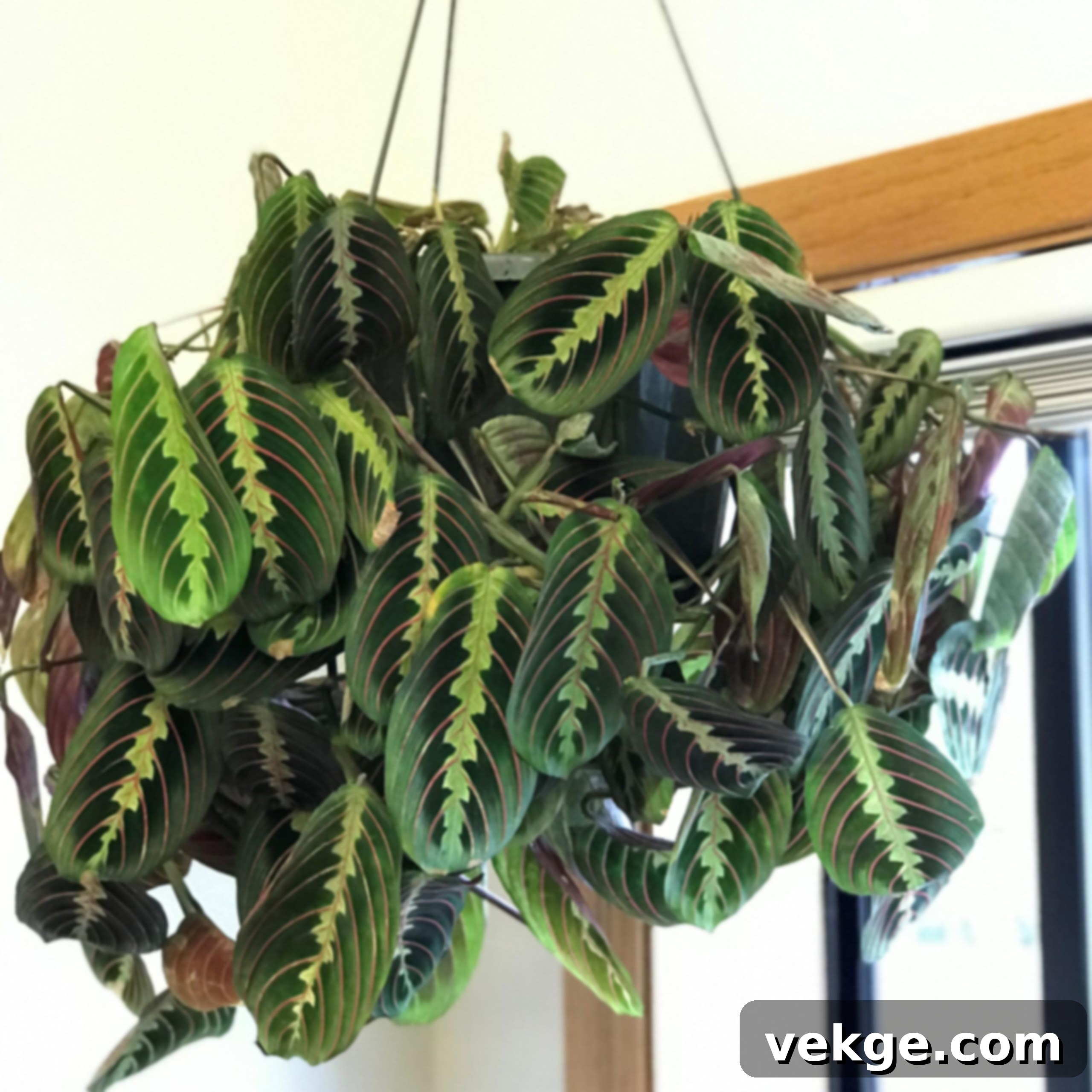
- Plant Appearance: The Prayer Plant is renowned for its strikingly beautiful, oval-shaped leaves adorned with unique patterns and vibrant colors. Typically, the leaves feature intricate veins in shades of red, pink, or dark green against a lighter green background, with purple undersides. Its most captivating feature is its nyctinastic movement: the leaves fold upwards at night, resembling hands in prayer, and then flatten out again in the morning.
- Price: Moderately priced, Prayer Plants generally range from $10 to $25, making this dynamic plant accessible to many.
- Growth Habits: This plant has a low-growing, spreading, and gently trailing habit as it matures. It’s ideally suited for hanging baskets, where its colorful foliage can gracefully spill over, or as a striking tabletop plant in a wide, shallow planter.
| Why I Should Have This | Creative Styling Tips | Care Guide |
|---|---|---|
| Its unique “folding leaf” movement adds an interactive and captivating element to your home, making it a truly living piece of decor. | Display it in hanging pots or on shelves to fully showcase its vibrant colors and intricate patterns, especially where its nightly “prayer” can be observed. | Light: Thrives in low to medium indirect light. Direct sunlight will scorch its leaves and fade its vibrant colors. |
| The Prayer Plant adds an explosion of color and intricate patterns to any space, instantly brightening and enriching your decor with its artistic foliage. | It’s perfect for a cozy corner, a shaded window area, or as a bedside plant, bringing a sense of calm and natural artistry. | Water: Keep the soil consistently moist but never soggy. Use filtered or distilled water if your tap water is hard, as it can be sensitive to chemicals. |
| Its natural preference for low-light conditions makes it an excellent choice for rooms that don’t receive much direct sunlight, thriving where other plants might falter. | Pair it beautifully with other trailing plants that appreciate humidity, creating a layered and lush display that benefits from shared environmental conditions. | Soil: A well-draining, slightly acidic potting mix rich in organic matter is ideal. A mix suitable for ferns often works well. |
| Beyond its beauty, it’s non-toxic to pets, making it a safe and worry-free choice for indoor spaces with furry friends. | Place it in a decorative pot that complements its vibrant colors, enhancing its visual impact as a centerpiece or accent. | Humidity: Requires high humidity to prevent leaf edges from crisping. Mist often, use a humidifier, or place it on a pebble tray. |
17. Chinese Money Plant (Pilea peperomioides)
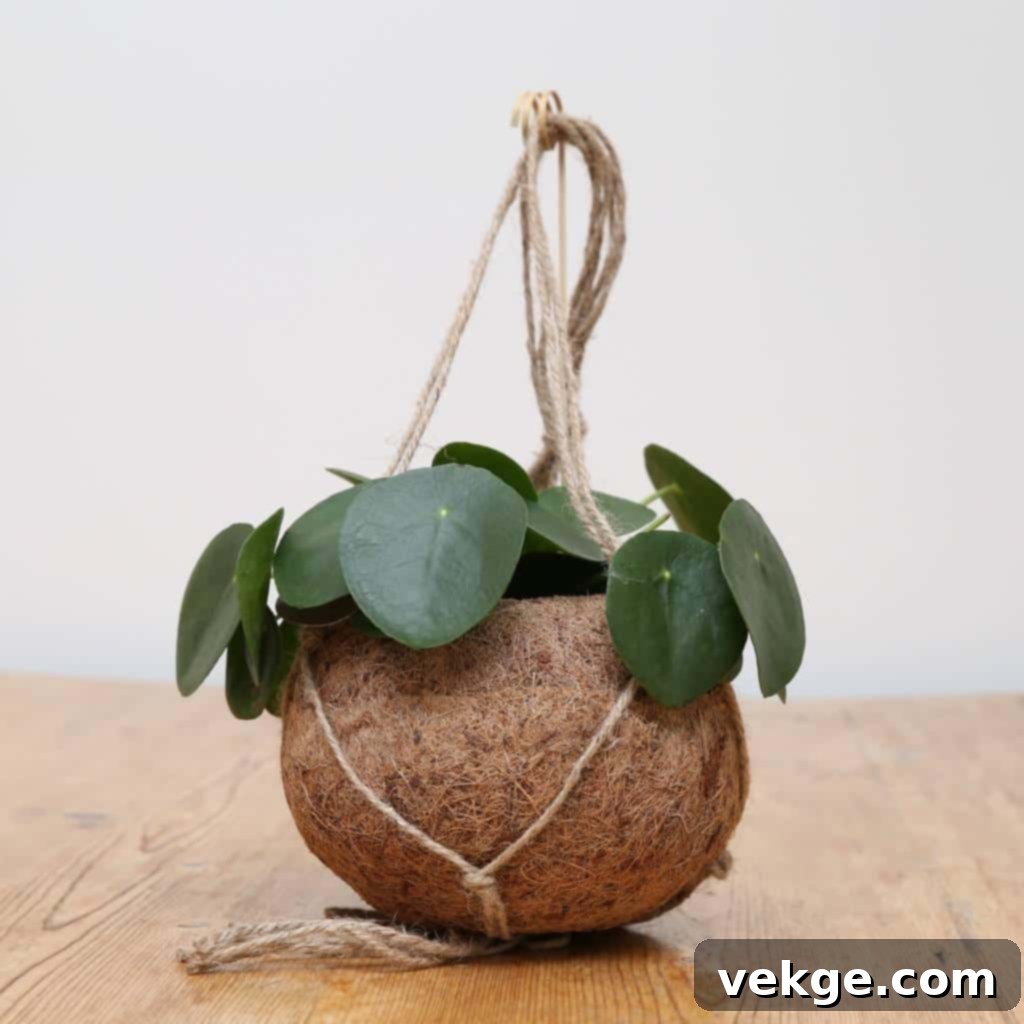
- Plant Appearance: The Chinese Money Plant is instantly recognizable by its distinct round, coin-shaped, bright green leaves that grow on slender, upright stems. These leaves fan out horizontally, creating a unique, modern, and sculptural look that is highly sought after. It often produces small “baby” plants from its base.
- Price: Moderately priced, usually ranging from $15 to $30, though smaller “pups” might be found for less.
- Growth Habits: Primarily an upright grower, its leaves fan out in an attractive, architectural manner. As it grows larger and produces pups, it can also be very charming in hanging pots, allowing the pups and the main plant’s lower leaves to spill gently over the edges, or as a captivating tabletop display.
| Why I Should Have This | Creative Styling Tips | Care Guide |
|---|---|---|
| Its unique, perfectly round, coin-shaped leaves offer a distinctive aesthetic that adds a touch of modern elegance and clean lines to any decor. | For a minimalist and modern touch, place it in a small, sleek hanging planter or a simple geometric pot on a shelf, allowing its leaves to fan out artistically. | Light: Prefers bright, indirect light. Direct sun can burn its leaves, while too little light can lead to leggy growth. |
| The Chinese Money Plant is known for being easy to care for and relatively low-maintenance, making it a great option for both beginners and experienced plant parents. | Position it on a prominent shelf or in a hanging pot where its unique leaf arrangement can be fully appreciated as a natural sculpture. | Water: Water when the top inch or two of soil is dry to the touch. Ensure good drainage to prevent waterlogging. |
| Its clean form and vibrant green color contribute to a minimalist and contemporary aesthetic, fitting seamlessly into modern interior designs. | It pairs exceptionally well with other modern decor elements like minimalist vases, abstract art, or concrete planters, enhancing a sophisticated style. | Soil: A well-draining potting mix that allows for good aeration is essential. A standard indoor plant mix with added perlite works well. |
| Its contained growth habit and unique appeal make it a perfect plant for small spaces, adding character without overwhelming the area. | Propagate the “pups” that emerge from the soil to create new plants, perfect for sharing with friends or expanding your collection. | Humidity: Tolerates average household humidity levels. It doesn’t require high humidity, but occasional misting won’t hurt. |
18. Wandering Jew (Tradescantia zebrina)
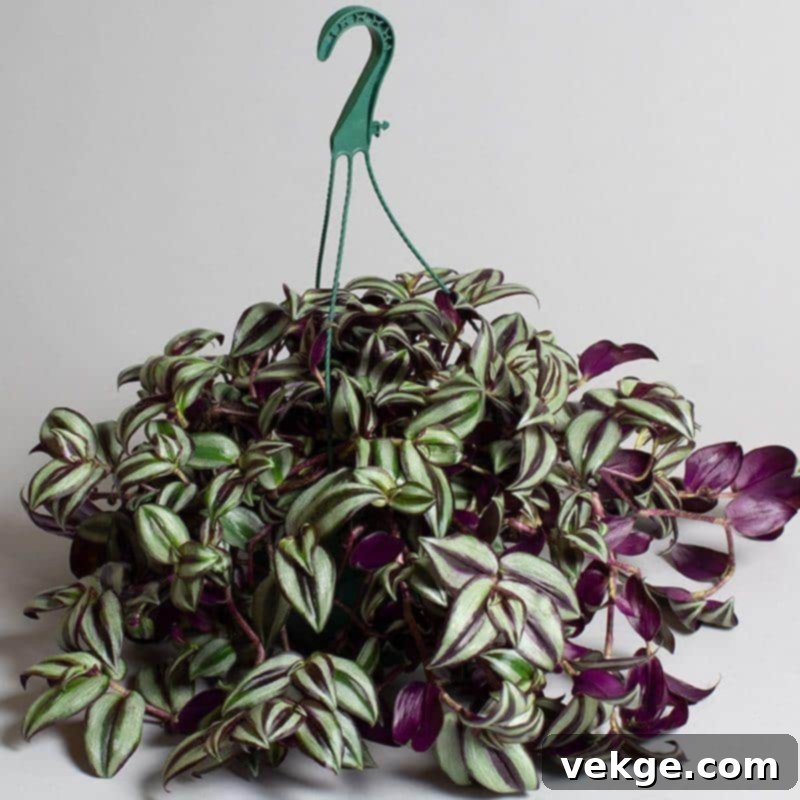
- Plant Appearance: The Wandering Jew (now often referred to as Inchplant) is celebrated for its incredibly striking and colorful leaves. Its foliage typically features vibrant purple and green stripes, often with a shimmery, glossy texture and a metallic sheen. The undersides of the leaves are a rich, solid purple, adding depth to its appearance. It grows in long, lush trailing vines.
- Price: Extremely affordable and incredibly easy to propagate, Wandering Jew plants usually cost between $5 and $15, making them a fantastic value.
- Growth Habits: This plant is a rapid and enthusiastic trailer, making it absolutely perfect for hanging baskets where its long, colorful vines can cascade freely and profusely, creating a stunning waterfall of color. It also looks beautiful spilling down from shelves or window ledges.
| Why I Should Have This | Creative Styling Tips | Care Guide |
|---|---|---|
| Its vibrant purple hues and striking striped patterns add a bold splash of color and visual drama, instantly enlivening any room. | Hang it in a bright room where it receives ample indirect light to truly enhance and showcase its stunning, vibrant purple and silver-green colors. | Light: Thrives in bright, indirect light. While it tolerates lower light, the colors will be less vibrant. Avoid direct sun, which can burn the leaves. |
| Known for its incredibly fast growth rate and ease of propagation, you can quickly grow a lush display and easily share cuttings with friends. | It’s an excellent choice for hanging baskets and mixed plant displays, providing a colorful and trailing element that fills space beautifully. | Water: Water when the top inch of soil feels dry. Keep the soil consistently moist but never soggy to prevent root rot. |
| Its prolific growth makes it perfect for creating abundant, lush displays that add depth and a touch of the tropics to your indoor spaces. | Pairs wonderfully with other tropical plants that feature solid green or light-colored foliage, creating a striking and vibrant color contrast. | Soil: A well-draining, general-purpose potting mix with good aeration is suitable. |
| Its adaptability and colorful nature make it suitable for various indoor spaces, from bright living rooms to more moderately lit bedrooms. | For an even fuller look, pinch back the stems regularly to encourage bushier growth and prevent legginess. | Humidity: Prefers moderate humidity. Occasional misting, especially in dry environments, can help keep its foliage looking fresh and vibrant. |
19. Arrowhead Plant (Syngonium podophyllum)
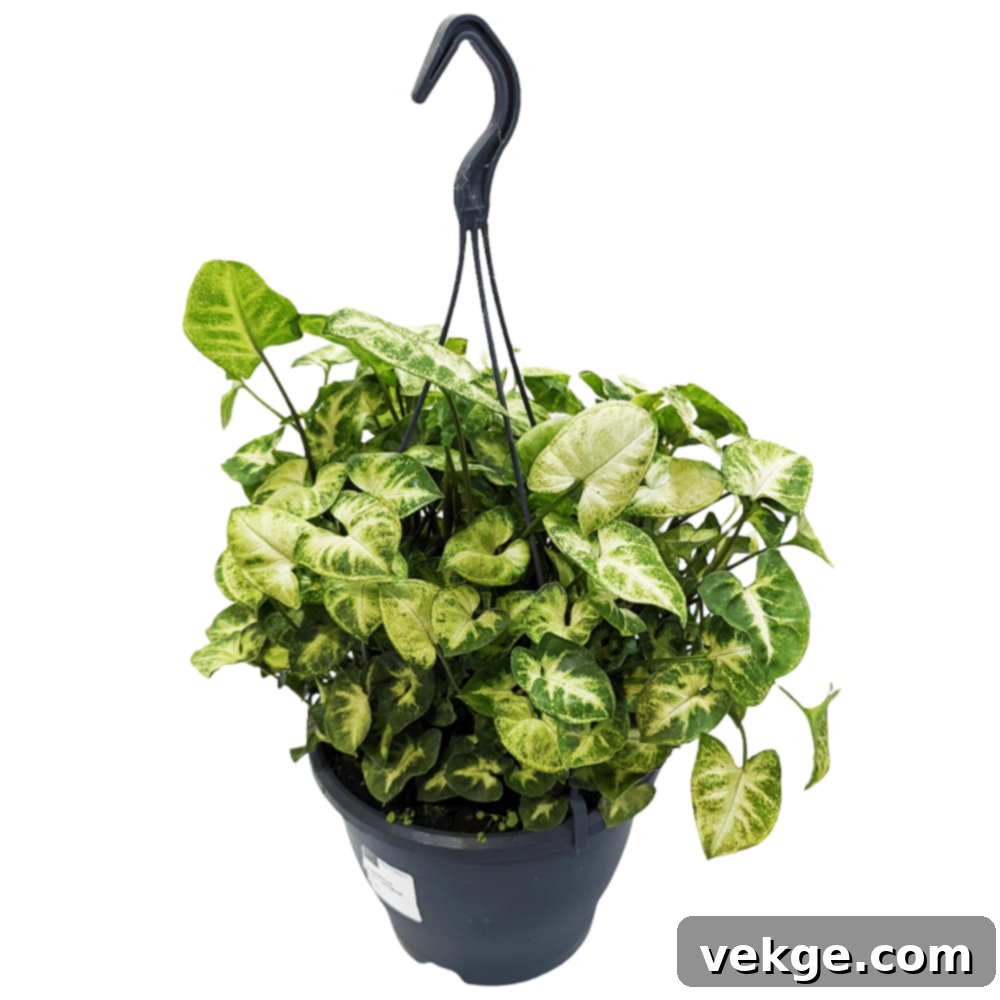
- Plant Appearance: The Arrowhead Plant is cherished for its distinctive arrow-shaped leaves. Young leaves typically start as a solid, vibrant green, but as the plant matures, many varieties develop beautiful variegation, with splashes of white, pink, or cream, adding intricate patterns and depth.
- Price: Highly affordable and readily available, Arrowhead Plants generally range from $5 to $20, depending on size and specific variegation.
- Growth Habits: This plant displays a fascinating growth evolution. It starts bushy and compact when young, making it great for tabletops. As it matures, its vines lengthen and begin to trail or climb, making it perfectly suited for hanging baskets or shelves where it can cascade elegantly.
| Why I Should Have This | Creative Styling Tips | Care Guide |
|---|---|---|
| Arrowhead Plants are remarkably easy to care for and highly adaptable, making them a resilient choice for a wide range of indoor conditions. | Utilize its adaptable growth by placing young, bushy plants on shelves, and mature, trailing ones in hanging pots for a dynamic, multi-level display. | Light: Thrives in low to medium indirect light. Direct sunlight can scorch its leaves, while too little light can lead to loss of variegation and leggy growth. |
| Its lush foliage and often variegated patterns bring a distinct tropical vibe to any space, creating an exotic and refreshing atmosphere. | It looks fantastic when mixed with other trailing plants in a larger container, contributing its unique leaf shape and color to a vibrant green medley. | Water: Water when the top inch of soil feels dry to the touch. Keep the soil consistently moist but not soggy. |
| It performs exceptionally well in low to medium indirect light, making it an ideal candidate for brightening up less illuminated rooms. | Perfect for creating a lush, green indoor space, whether in a living room, office, or bathroom, enhancing a natural aesthetic. | Soil: A well-draining, general-purpose potting mix with good organic content is suitable. |
| Its forgiving nature and captivating appearance make it a superb choice for plant beginners who want to add variety and texture to their collection. | Encourage bushier growth by pinching back the tips of longer vines, or let it climb a moss pole for a more vertical display. | Humidity: Prefers moderate humidity. Regular misting, especially during dry periods, can prevent leaf crisping and encourage healthy growth. |
20. String of Turtles (Peperomia prostrate)
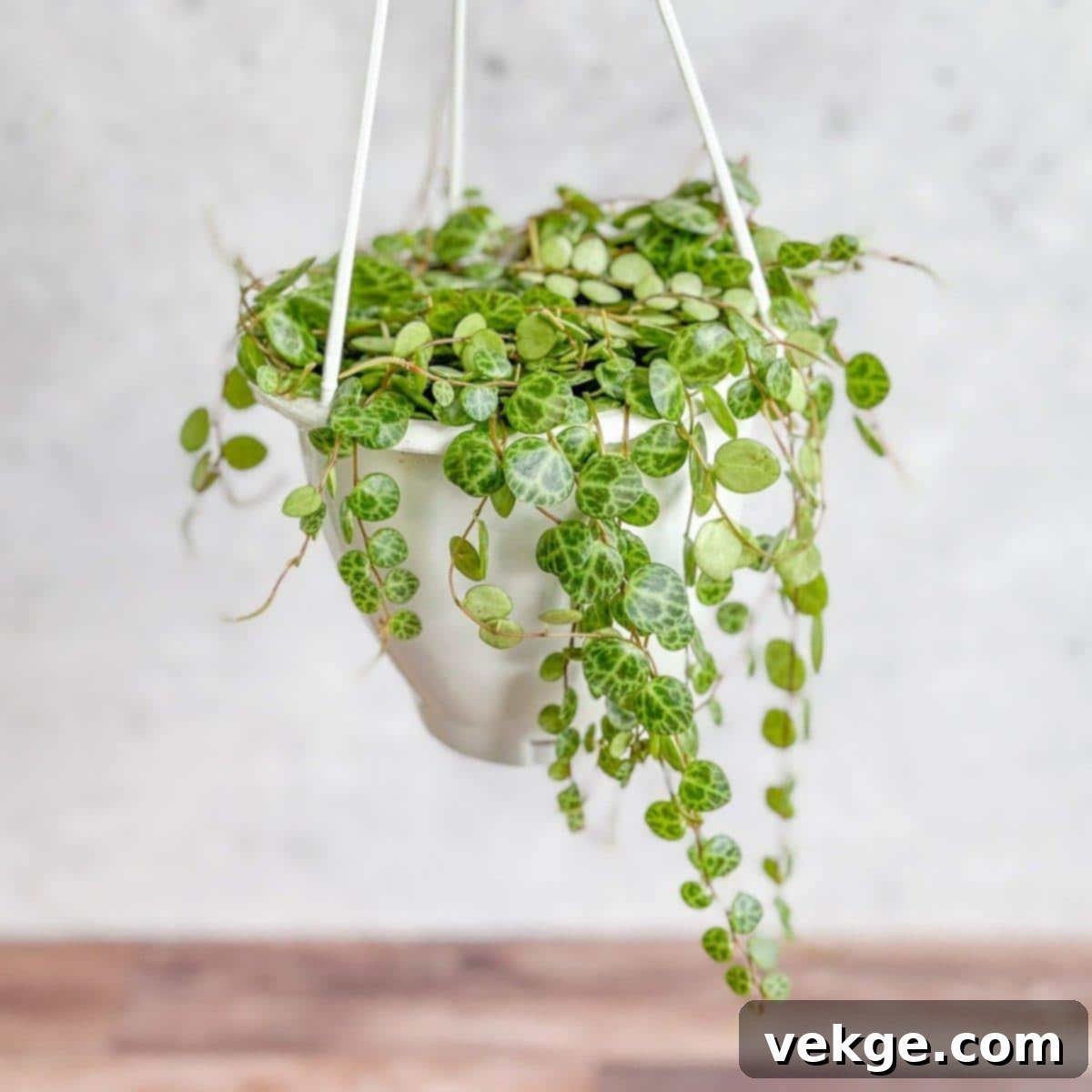
- Plant Appearance: The String of Turtles is a miniature marvel, featuring small, round, succulent-like leaves with an incredibly unique and intricate pattern resembling tiny turtle shells. These delicate leaves grow densely along thin, trailing vines, creating a captivating visual texture that is both charming and distinctive.
- Price: Moderately priced, String of Turtles typically ranges from $10 to $25, reflecting its unique appeal and popularity among collectors.
- Growth Habits: This plant is an exceptional trailing specimen, ideally suited for hanging baskets or high shelves where its delicate vines, adorned with “turtle shells,” can cascade gracefully downwards, creating a truly enchanting display.
| Why I Should Have This | Creative Styling Tips | Care Guide |
|---|---|---|
| Its utterly unique and beautifully patterned leaves make it a delightful addition, adding character and a whimsical touch to any plant collection. | Hang it in a bright room where its stunning, intricate patterns on the leaves can be fully appreciated and admired. | Light: Prefers bright, indirect light. Direct sun can scorch the delicate leaves, while too little light can reduce the vibrancy of its patterns. |
| Its delicate size and contained growth make it excellent for small spaces, adding charming greenery without taking up much room. | Perfect for small hanging pots, miniature terrariums, or nestled within mixed succulent displays, adding unique texture and visual interest. | Water: Allow the soil to dry out completely between waterings, then water thoroughly. As a semi-succulent, it’s prone to rot if overwatered. |
| The String of Turtles adds incredible character and texture to decor, drawing the eye with its detailed foliage and gentle trailing habit. | Place it on a windowsill or shelf where it can receive adequate light but is protected from harsh, direct afternoon sun. | Soil: Requires a very well-draining, airy cactus or succulent mix to prevent water retention and root issues. |
| It’s relatively easy to care for and drought-tolerant due to its semi-succulent nature, making it a forgiving choice for beginners. | For a fuller appearance, prune leggy stems. You can easily propagate the cuttings to create more of these charming plants. | Humidity: Tolerates average household humidity levels. It does not require high humidity and can suffer if conditions are too damp. |
21. Neon Pothos (Epipremnum aureum ‘Neon’)

- Plant Appearance: A striking cultivar of the classic Pothos, ‘Neon’ Pothos is distinguished by its incredibly bright, vibrant, lime-green to chartreuse leaves. Unlike other Pothos varieties, its foliage is a solid, electrifying color that instantly stands out and brings a burst of brilliant hue to any space.
- Price: Moderately priced, typically ranging from $10 to $20, slightly more than common Pothos varieties due to its unique coloration.
- Growth Habits: Like its Pothos relatives, ‘Neon’ Pothos is an excellent and vigorous trailer, making it superb for hanging baskets where its dazzling vines can cascade freely, or for trailing gracefully from shelves and cabinets.
| Why I Should Have This | Creative Styling Tips | Care Guide |
|---|---|---|
| Its electrifying, neon-colored leaves provide an unparalleled pop of vivid color, instantly brightening up even the dullest corners of a room. | Utilize its vibrant foliage in hanging baskets placed strategically to highlight its brilliant color, creating a focal point in any room. | Light: Thrives in low to medium indirect light. Brighter indirect light can enhance its neon color, but avoid direct sun, which can bleach or burn the leaves. |
| ‘Neon’ Pothos is incredibly easy to care for and highly adaptable to various indoor conditions, making it a forgiving and resilient choice for any plant owner. | Perfect for kitchens or bathrooms, its bright accent can energize these functional spaces, adding a touch of cheerfulness and natural glow. | Water: Allow the top 2-3 inches of soil to dry out completely between waterings. It’s better to slightly underwater than overwater to prevent root rot. |
| Beyond its beauty, it’s an effective air-purifying plant, helping to remove common indoor toxins, and its hardy nature ensures long-lasting enjoyment. | It is ideal for pairing with darker green plants or plants with deep red hues for a dramatic and visually stimulating contrast in a mixed display. | Soil: A well-draining potting mix that allows for good aeration and prevents waterlogging is essential. |
| Its robust nature and striking appearance make it an outstanding choice for beginners looking for a vibrant, easy-to-grow houseplant. | Let its vines trail around a window frame or along a shelf, creating a lively, flowing green garland that catches the light. | Humidity: Prefers moderate humidity but tolerates average household levels. Occasional misting or a pebble tray can encourage even lusher growth. |
How to Care for Low-Light Hanging Plants: Essential Tips
While the plants on our list are chosen for their resilience in low-light conditions, providing them with the right care ensures they don’t just survive, but truly thrive and fill your home with vibrant energy. Here are some essential general care tips to keep your low-light hanging plants healthy and happy:
- Understand “Low Light”: “Low light” doesn’t mean no light. It refers to areas that receive indirect or filtered light for most of the day, or rooms with windows facing north. Avoid placing these plants in dark, windowless corners without any supplemental light, as even the hardiest low-light plants need some illumination to photosynthesize.
- Watering Wisdom: This is often the trickiest part. Low-light plants generally require less water than their high-light counterparts because they photosynthesize slower and use less moisture. Always check the soil moisture before watering. Stick your finger about an inch or two into the soil; if it feels dry, it’s time to water. Overwatering in low-light conditions is the quickest way to cause root rot. Ensure your hanging baskets have drainage holes to prevent waterlogging.
- Humidity Matters: Many low-light plants, especially ferns and tropical varieties, originate from humid rainforest understories. While they adapt to average household humidity, they will appreciate a boost. You can achieve this by misting regularly (especially in dry climates), placing plants on a pebble tray filled with water, or grouping them together to create a microclimate. Bathrooms and kitchens often offer naturally higher humidity.
- Right Soil, Right Pot: Use a good quality, well-draining potting mix. A mix that retains some moisture but also allows for good aeration is ideal. Ensure your hanging pot has proper drainage holes to prevent soggy soil, which is detrimental to most plants. Consider lighter plastic pots for hanging, or use macrame hangers for heavier ceramic options.
- Fertilization (Less is More): Low-light plants have slower growth rates, so they require less fertilizer. Feed sparingly, perhaps once every 2-4 months during their active growing season (spring and summer) with a diluted, balanced liquid fertilizer. Avoid fertilizing in fall and winter when growth naturally slows down.
- Pest Patrol: Even low-light plants can attract pests. Regularly inspect the undersides of leaves and stems for any signs of common houseplant pests like spider mites, mealybugs, or aphids. Early detection and treatment (e.g., with neem oil or insecticidal soap) are key.
- Pruning for Health and Shape: Don’t be afraid to prune! Trim off any yellowing, browning, or leggy stems to encourage bushier growth and maintain a neat appearance. Pruning also helps redirect the plant’s energy towards new, healthy growth.
[INSERT THE VIDEO GIVEN BELOW]
Conclusion: Embrace the Green in Every Corner
So, there you have it – a diverse and delightful collection of 21 beautiful low-light hanging plants, carefully chosen to brighten up your living space, no matter how dim or challenging the lighting conditions might be. From the easy-going Pothos and Spider Plant to the uniquely patterned Prayer Plant and the striking Staghorn Fern, this list offers a wealth of options to transform even your darkest corners into lush, vibrant havens.
I genuinely hope this comprehensive guide has inspired you to confidently bring more greenery into those tricky, darker areas of your home. Remember, a lack of direct sunlight doesn’t mean you can’t cultivate a thriving indoor garden. These adaptable, low-maintenance beauties are ready to add texture, color, and fresh air to your life, proving that every space, no matter how small or shaded, can be a sanctuary of natural beauty.
Even with these resilient low-light plants, a little consistent care goes a long way. Pay attention to their specific watering needs, ensure adequate humidity, and always remember to check the soil before adding more water. Start with one or two plants that truly catch your eye and fit your lifestyle, and you’ll quickly find yourself falling in love with the serene joy and vibrant energy they bring to your home. Before you know it, you’ll be a confident low-light plant parent, eager to explore even more green possibilities!
Do you already have a favorite low-light hanging plant that’s flourishing in your home? Or perhaps you’ve got a question about caring for one of these magnificent green companions? I’d absolutely love to hear from you and learn about your experiences! Drop a comment below, share your tips, or ask away, and let’s chat about our leafy friends and how they enhance our living spaces.
Happy Planting!
